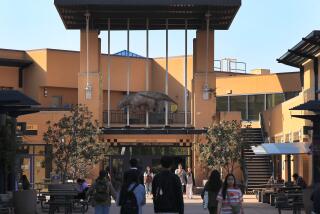Applicants Outpace University Budget
During the four-day Thanksgiving break, the admissions office at Cal State Channel Islands was flooded with more than 1,000 freshmen applications.
A week later, Gov. Gray Davis proposed state budget reductions that could mean drastic program cuts for the new campus near Camarillo, which opens its doors to freshmen for the first time next fall.
These conflicting mandates -- to meet enrollment demand while shrinking its budget -- present a major challenge for a young university that has no student union, residence halls or sports teams.
“It’s called a double whammy,” university President Richard Rush said. “It’s certainly better to be popular than to be unpopular. But in this climate, we’re not going to get money to serve more students than we planned for.”
For the fall term, the university’s budget allows for about 250 freshmen, said W.M. Gregory Sawyer, vice president of student affairs. He received 2,200 applications in the one-month application period that closed Dec. 16. The volume of freshmen applications surprised him, Sawyer said.
“At the time we hadn’t even been open a semester,” Sawyer said. “That’s pretty amazing.”
The scope of the dilemma won’t be known until at least February, Sawyer said, when he learns how many of the 2,200 students qualify for Cal State Channel Islands and how many are planning to attend.
By then, Rush should also know how much money he will have to cut from the university’s budget. He said he has asked Cal State officials to go easy on his campus as they ponder how to slash $60 million in spending to help close a projected $30-billion state budget deficit while in the middle of an academic year.
“As a brand new campus, we don’t have any wiggle room in the budget,” Rush said. “I’ve asked ... if we could get a life raft on this one.”
Earlier this month, CSU officials agreed to hike student fees by 10% -- about $72 a semester -- to help cover shortfalls.
“Nobody’s happy about this,” Rush said.
This fall, Rush said, he had to trim $400,000 from the school’s small budget, and it wasn’t easy. It will be even more difficult in the next round, he said, because most departments on the start-up campus are staffed by only one person. In many cases, to cut personnel is to cut an entire service for students, he said.
“A mature institution has some flexibility we don’t have yet,” Rush said. “Certainly if we are cut significantly, we’re going to have to stop doing an awful lot of things we do.”
As Ventura County’s first public four-year university, Rush said, the new campus is committed to serving local students. He and Sawyer said the lack of on-campus housing will deter students from faraway areas.
That didn’t stop them from applying, however. Of the 2,200 freshmen applicants, about 1,700 are from outside commuting range -- mainly Northern California and San Diego, Sawyer said. About 500 students are from Ventura County and surrounding areas.
State schools must accept all students who meet the minimum entrance requirements, Sawyer said, regardless of whether there is space for them. The average “yield rate” -- the number of students who apply versus the number who show up on the first day of classes -- averages about 25% at other Cal State campuses.
That means the new university could potentially end up with 550 students, or double the number it has the money to serve next August, officials said.
What then?
“My understanding is we serve them,” Sawyer said.
An “enrollment management team” made up of professors, university staff members and administrators must deal with the issue, Sawyer said.
They will start by calling students who have been accepted to find out if they intend to enroll. After that, they will start crunching numbers. “For all of us, this is a really unique challenge,” Sawyer said. “We have to figure out how we’re going to continue providing quality instruction in a budget-crunch year.”
More to Read
Sign up for Essential California
The most important California stories and recommendations in your inbox every morning.
You may occasionally receive promotional content from the Los Angeles Times.










